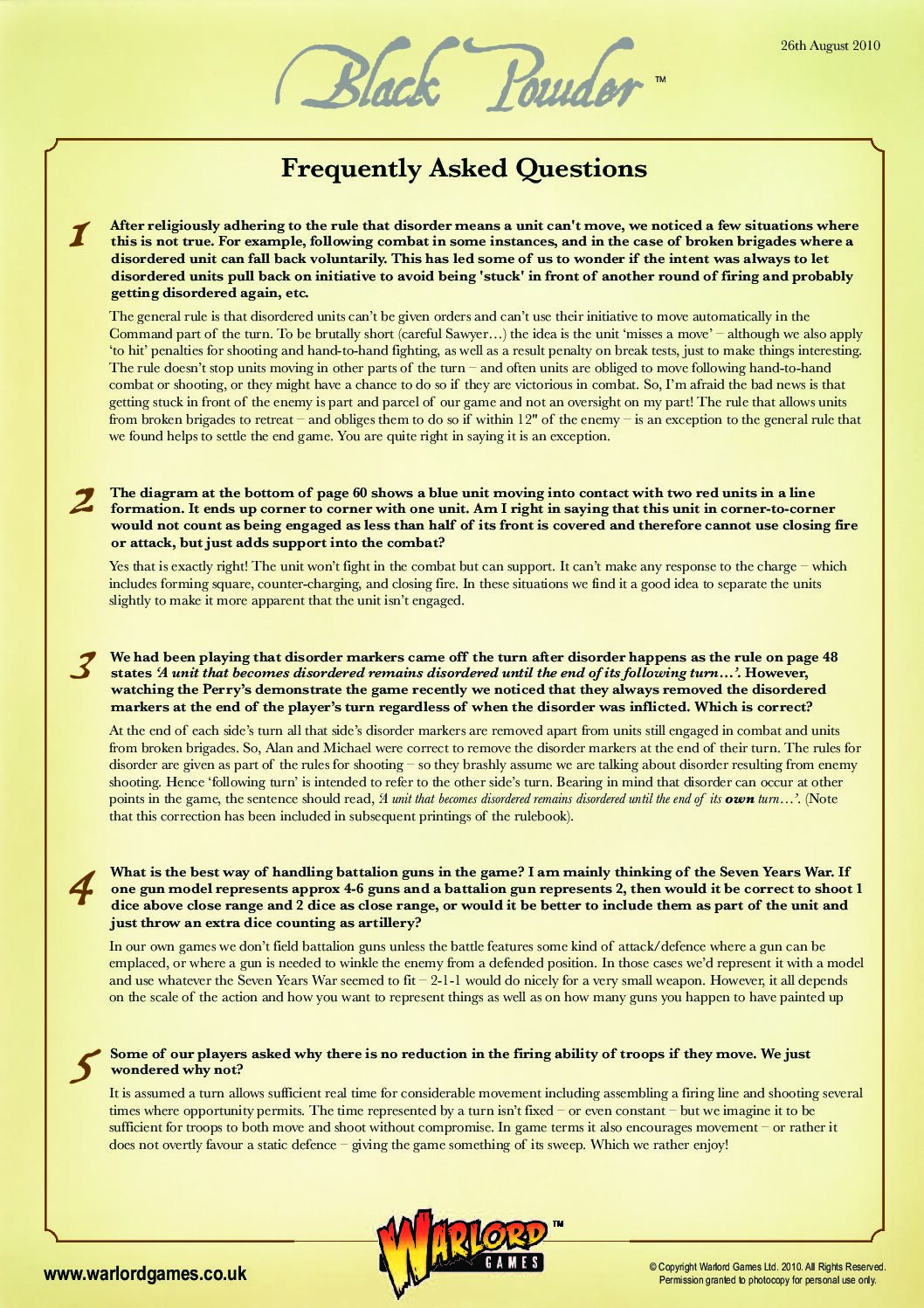Main BP2 rulebook v Epic Battle rulebook
Home › Forums › Historical › Black Powder › Main BP2 rulebook v Epic Battle rulebook
- This topic has 20 replies, 4 voices, and was last updated 2 years, 2 months ago by
 Garry Wills.
Garry Wills.
-
AuthorPosts
-
March 17, 2022 at 11:51 pm #187362
 East NorfolksParticipant
East NorfolksParticipantThanks Al – I agree with most of what you say except “all Unclear Target does is excuse you from shooting at the closest target”. This is not quite correct – it also gives you a -1 to hit modifier which can be important, especially in decisive moments.
March 18, 2022 at 7:03 am #187363 Big AlParticipant
Big AlParticipantYes, but it isn’t that big a deal compared to the risk factor that I mentioned caused by ignoring the unit.
Remember the rule about only being allowed to contact the quarter that your unit starts its turn in. If the majority of the unit is in your flank quarter, it can only contact that quarter if it charges, regardless of how far away it is and how much it manoeuvres.
A -1 to hit for shooting is minor compared to the effect of being charged in the flank. You are then reduced to half of your attacks, rounded down and -1 to hit, is not good against a unit with full attacks and hitting you on 3+. I was looking at that bigger picture!😀
April 24, 2022 at 11:42 pm #187581Ken Drushal
ParticipantFirst time user of the Black Powder system and have a copy of the Epic Battles rulebook from the starter set.
I’m hoping that these three questions are either omissions from the main BP2 rules or simple cut and paste errors. All page references are from the Epic Battles rulebook.
- How to you become Disordered in Hand to Hand combats?
On page 48 the first sentence under Disorder; “Disorder can occur as a result of shooting <u>or during close combat</u>…”. I found how it happens during shooting easily enough. However, from pages 60 through 75 (especially 74 & 75 Fighting Combat) it is not mentioned that a unit can be Disordered during Hand to Hand combat let alone how.
- When does the winner in hand to hand take a ‘break test’? It would seem that this would only happen if he took more casualties in the combat than its stamina value. But when, within the sequence, does this occur so that the excess casualties can be removed.
- How do ‘Division Commanders’ work within the rules?
Referencing The Battle of Quatre Bras OOB on page 244.
Assuming C-in-C: Marshal Ney (Staff Rating 8) is the ‘General’ following the definition on page 8 and has the abilities from page 27.
Then there’s Campi’s Brigade (Staff Rating 7) of 5 battalions and Husson’s Brigade (Staff Rating 7) of 4 battalions. These two would be ‘Brigade Commanders’ as defined by the rules on pages 8 & 20.
So what about Bachelu’s Division (Staff Rating 7)? The only two command levels I’ve seen in the rules are ‘General’ and ‘Brigade Commander’, no other intermediate levels of command are mentioned.
Thanks, in advance for any feedback.
April 25, 2022 at 7:08 am #187585 Big AlParticipant
Big AlParticipantHi Ken
1) Disorder in hand to hand combat occurs as a result of the break test. Generally, it is the loser of the combat that takes a break test. I say generally because if the combat ends in a draw, either or both combatants could end up taking the test. If either combatant is shaken at the end of a drawn combat – Only a drawn combat – then they take a break test. If one fails and retires or worse, the combat is still a draw. The other combatant has not won just because the break test was failed by the opponent.
The other instance is when the fighting unit gets a break result. Then, any units in a supporting position, regardless of whether they were actually used as support or not, must take a break test. This is an unmodified roll and is taken regardless of whether the units have suffered any casualties or not. Poor dice rolling could see a Brigade decimated.
2) The winner of a Combat never takes a break test, regardless of their condition. They are elated at having defeated their opponents and carry on as normal. You will see all of the conditions where a break test is required listed on page 77 of the main BP2 rulebook and explanations follow it.
3) Brigade Commanders are the chaps issuing the orders to the units within their division. You roll against their Command Rating to see how successfully the order was received. As you may know, if you roll equal to or 1 less than the Command Rating (CR) the unit can make one move. If the roll is 2 less than the CR the unit can make two moves. If the roll is 3 or more below the CR, the unit may make three moves. The CR can be affected by modifiers, for example +1 if the unit is in Column (+2 if on a road as well), -1 if within 12 inches of an enemy and so on.
However, if your game is large enough to be using Divisions, then each Division will be a small army. Each Divisional Commander will be a General and act in the same way as the General would do in a smaller game. Most likely, you will have other players involved, with each player taking the role of a Divisional Commander. This may mean that the Army General just issues orders or requirements to his Divisional Commanders who then execute them according to their interpretation.
Hope that helps. I will poo)t out that I do not have the Napoleonic Epic set, so I do not know if there is anything in the leaflet about Divisional Commanders and the General. What I have given you is how it is normally played and Common sense from my experience of playing Black Powder since it was released.
April 27, 2022 at 11:57 pm #187606Ken Drushal
ParticipantThanks for the response Big Al.
1) So there’s no mechanic IN Hand to Hand Combat that causes a Disorder result, got it. Makes the reference I mentioned very misleading.
2) Okay, so the winner takes any casualty counters in excess of his Stamina value into the next turn.
3) There is no mention of Division Commanders anywhere in the rules, only as headers in the scenarios. Your explanation seems to make sense, however it does lead to some other questions (for a later time).
Again, thanks.
April 29, 2022 at 10:48 am #187613 Garry WillsParticipant
Garry WillsParticipant1. Well that is a bit unfair, the break tests are integral to the close combat results section.
2. No the victorious units excess casualties are removed after all the ‘necessary break tests’ have been done. This is a case of the rules not being explicit as the victorious units don’t need to take break tests. However it is implied by how the rules are written for shooting casualties and defeated units. It also has to be this way because in the scenario in which a defeated unit survives its break test and remains in contact (and removes its excess casualties), the victorious would be at a significant disadvantage in the next round of close combat, if it hadn’t removed its excess casualties. The rules could be clearer on this point, but if you follow the logic it is pretty clear that this is what is intended. This interpretation became ‘official’ in the August 2010 FAQ #6. The FAQ’s are well worth having to hand.
3. The division commanders will be very scenario specific but the division commanders and corps commanders are covered in the Clash of Eagles supplement. Scenario design for all historical games requires a reasonable amount of effort, which is why books of scenarios sell so well.
Lets us know the other questions you have.
All the best
Garry
Attachments:
-
AuthorPosts
- You must be logged in to reply to this topic.

